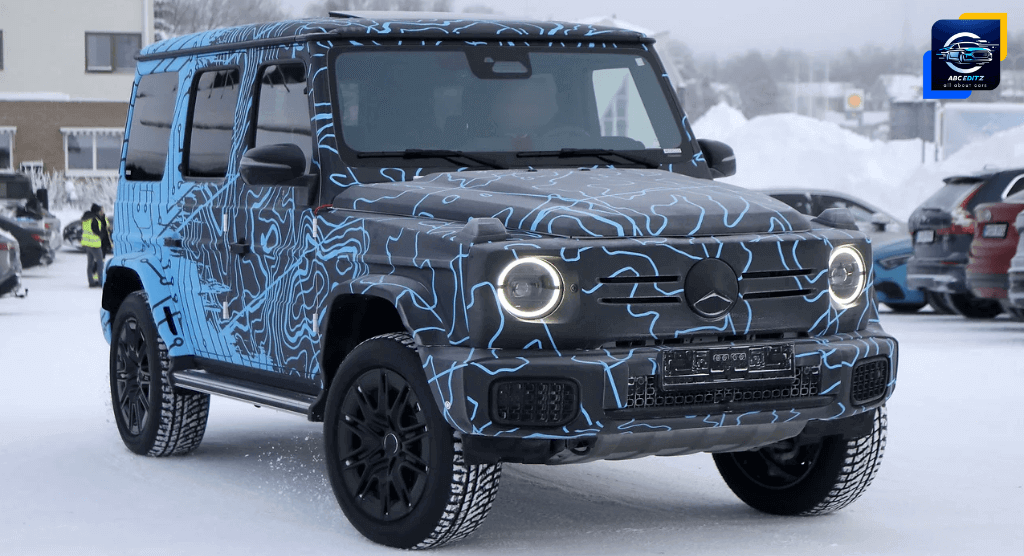An electric SUV with a retro-inspired design, based on the G-Class, will match the formidable power of the G 63 AMG and feature an exclusive G-Turn function.

The anticipation builds as Mercedes-Benz embarks on rigorous durability tests for the EQG EV SUV, utilizing a fleet of prototypes that have proudly completed two years of their transformative four-year engineering journey.
Set to be based on the iconic W463 G-Class and manufactured in the heart of Austria, the EQG will redefine the off-road experience with its electric drivetrain boasting four electronic motors. This electrifying revelation follows the EQG’s captivating preview as a concept at last year’s Munich Motor show, heralding a new era of electrification for the revered G-Class, an automotive icon since its inception in 1979.
More than just an electric vehicle, the EQG is destined to serve as the technological vanguard for Mercedes-Benz’s newly forged G sub-brand, standing as a testament to innovation and the unwavering spirit of the Geländewagen. As we await the dawn of this electrifying chapter, the EQG promises not just a vehicle but a captivating journey into the future of automotive excellence.
Mercedes-Benz EQG Electric SUV: chassis
Built on the latest iteration of the G-Class, known as the W463, the EQG utilizes a modified version of the steel ladder-frame chassis found in traditional internal combustion-engine models. Production will take place alongside its counterparts at Magna Steyr’s plant in Graz, Austria.
Early prototypes of the EQG on the road affirm its commitment to the iconic square-rigged exterior styling seen in other G-Class models. Despite camouflage, these prototypes reveal standard body panels with unique touches, including a redesigned front bumper and a grille that has been sealed off.
Diverging from other EQ models from Mercedes-Benz, the EQG lacks a front luggage compartment, and there’s no frunk. Instead, the charging cable finds its home in a lockable box, a concept previously previewed. This box is ingeniously mounted on the sideways-opening tailgate, replacing the traditional spare tire.
The heart of the EQG’s technological evolution lies in its novel electric drivetrain, featuring four electric motors—one for each wheel. This distinctive setup, unlike other EQ models from Mercedes-Benz, bears a resemblance to the SLS’s E-Cell produced by the AMG performance car division in limited volumes in 2013. Notably, this four-motor layout is also employed by the US electric vehicle startup Rivian in its R1 SUV and pickup.
The front electric motors are strategically positioned low on each side within the axle, while the rear electric motors are integrated more centrally within a newly designed de Dion-style rear axle specifically tailored for the EQG. This configuration aims to optimize traction and suspension flexibility. Each electric motor has the capability to independently drive each wheel through a mechanical two-speed gearbox, providing both high and low-range gearing.
Mercedes-Benz EQG Electric SUV: off-road tech
Mercedes-Benz is keeping mum on the precise power and torque details of its latest electric model. Nonetheless, the company hints at a range of models with varying outputs, including a flagship AMG version that is poised to rival the performance of the existing Mercedes-AMG G63 4Matic, equipped with a 577hp twin-turbocharged 4.0-liter V8.
In addition to the conventional on-road driving modes (Eco, Comfort, and Sport), the forthcoming G-Class will introduce three off-road modes—Trail, Rock, and Sand. An innovative creeper mode allows the driver to set a predetermined speed for off-road driving.
To enhance off-road capabilities, the four electric motors can mimic the functionality of the three locking differentials present in the internal combustion-engined G-Class models (one in each axle and one in the transfer case). In challenging conditions, the collective drive can be redirected to a single wheel to maintain traction and ensure progress.
A distinctive feature, known as the G-Turn function, activated by a dashboard-mounted button, empowers the electric motors on one side to turn the wheels forward, while those on the opposite side turn the wheels in reverse. This enables the EQG to execute on-the-spot 360-degree tank turns. The driver can choose the direction—left or right—via shift paddles on the steering wheel.
Thanks to the compact packaging of the front electric motors within the front axle, the front wheels can achieve a greater turning angle. Consequently, the turning circle of the EQG is described as “considerably better” than that of other internal combustion-engined G-Class models.
Mercedes-Benz EQG Electric SUV: battery
The new driveline is paired with a floor-mounted battery situated beneath the rear seat. This lithium-ion unit, boasting a usable energy capacity of approximately 100kWh, shares its cell technology with the EQXX concept. The introduction of a new silicon anode is asserted to enhance energy density and efficiency beyond that of the batteries in the recently revealed EQE and EQS SUVs, while concurrently reducing weight and overall size.
In line with other Mercedes-Benz EQ models, a regeneration system facilitates the harvesting of kinetic energy through three distinct steps – D+, D, and D-.
To safeguard the battery during extreme off-road conditions, it resides within a robust sealed case, enabling the EQG to confidently navigate through deep water. The steel casing receives an extra layer of carbon fiber-reinforced polymer compound, providing added protection against rock strikes and other impacts.
An inherent advantage of placing the battery in the floor is the significantly lower center of gravity for the EQG compared to the G-Class, even though there is a compromise on weight. The undercarriage features a double-wishbone front and trailing arm rear suspension, utilizing similar linkage points to the internal combustion-engined G-Class models.
While specific details such as ground clearance and approach, departure, and breakover angles are yet to be fully disclosed, Mercedes-Benz hints that the EQG is poised not only to match but potentially surpass diesel- and petrol-powered G-Class models in certain off-road scenarios.
Also Check – Mercedes Maybach EQS SUV dazzles the stage
